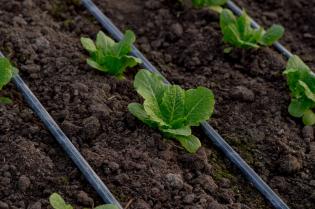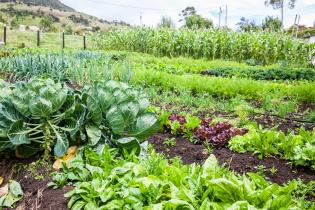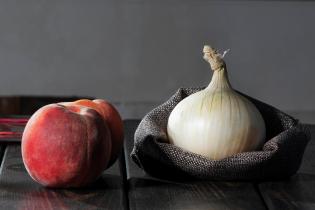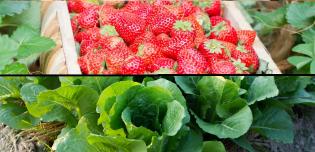Do you have a favorite article that you share with growers or processors when they ask, “Do I really need to do that?” Is there research that you point to emphasize why a practice is risky? If so, please share the article with Ellen. We’ll add it to this section of our website to help regulators and educators quickly find the science-based information their growers and processors need to make informed decisions.
 Authors:
Authors:
Bulut, Ece; Murphy, Sarah; Strawn, Laura; Danyluk, Michelle; Wiedmann, Martin; and Ivanek, Renata
Risk assessment of Escherichia coli O157:H7 along the farm-to-fork fresh-cut romaine lettuce supply chain
Conclusion: The risk assessment model presented here provides a comprehensive analysis of the impact of various preharvest and postharvest factors and their interactions. Our results suggest that illnesses occur mainly (52%) due to ECO157 contamination originating from untreated irrigation water applied through overhead spray irrigation. Our data further suggests that preharvest ECO157 risk, including that from irrigation, can be reduced either through water treatments or by switching to furrow or drip irrigation. In postharvest, maintaining the cold chain is crucial to prevent high numbers of illness cases. While our data indicates that an effective postharvest wash can help mitigate the public heath impact of both preharvest and postharvest contamination, future work on the impact of postharvest wash variability on public health risk is important.
 Authors:
Authors:
Devarajan Naresh , Weller Daniel L. , Jones Matthew , Adell Aiko D. , Adhikari Achyut , Allende Ana , Arnold Nicole L. , Baur Patrick , Beno Sarah M. , Clements Donna , Olimpi Elissa M. , Critzer Faith , Green Hyatt , Gorski Lisa , Ferelli Gruber Angela , Kovac Jasna , McGarvey Jeffery , Murphy Claire M. , Murphy Sarah I. , Navarro-Gonzalez Nora , Owen Jeb P. , Pires Alda F. A. , Richard Nicole , Samaddar Sandipan , Schmidt Radomir , Scow Kate , Shariat Nikki W. , Smith Olivia M. , Spence Austin R. , Stoeckel Don , Tran Thao
D. H., Wall Gretchen , Karp Daniel S.
Evidence for the efficacy of pre-harvest agricultural practices in mitigating food-safety risks to fresh produce in North America
ABSTRACT= Here, we present a comprehensive evidence synthesis evaluating the efficacy of soil, non-crop vegetation, animal, landscape, and irrigation water management strategies aimed at reducing produce-safety risk in North America. We systematically summarized findings from 78 peer-reviewed papers on the effect of 21 management practices on the prevalence, abundance, or survival of four foodborne pathogens. Overall, these findings provide insights into the food-safety impacts of agricultural and land management practices that growers, auditors, and extension personnel can use to co-manage produce preharvest environments for food safety and other aims.
 Principal Investigator:
Principal Investigator:
Nitin Nitin, Ph.D.
Co-Investigator:
Linda J. Harris, Ph.D.
Cross-contamination risks in dry environments
With extensive research, we have developed understanding of the risk factors that promote cross-contamination of fresh produce during wet handling and processing as well as developed tools and technologies to reduce these risk factors. The data generated in this project address the gaps in knowledge of factors influencing crosscontamination risks in dry environments. There are 12 key findings and recommendations.
 Authors:
Authors:
Manreet Bhullar, Bridget Perry, Ana Monge, Lillian Nabwiire, and Angela Shaw
Escherichia coli Survival on Strawberries and Unpacked Romaine Lettuce Washed Using Contaminated Water
The produce was washed with contaminated water, air-dried, and stored in display units for 7 days. The produce was sampled randomly each day and analyzed for the surviving E. coli count. The results indicated that E. coli can survive in both lettuce and strawberries over extended periods. A survival population of 2.3 log CFU/cm2 (day 8) was observed on lettuce with an initial population of 2.8 log CFU/cm2 (day 0). On strawberries, the population reduced from 3.0 (day 0) to 1.7 log CFU/cm2 (day 7), with an initial E. coli concentration of approx. 6 log CFU/mL in the wash water. Strawberry leaves had a higher attachment of E. coli than the fruit (p < 0.05). In conclusion, romaine lettuce and strawberries washed with contaminated water can cause an outbreak affecting consumers and public health.

Any opinions, findings, conclusions, or recommendations expressed in this publication are those of the author(s) and should not be construed to represent any official USDA or U.S. Government determination or policy.
This work is supported by the Food Safety Outreach Program [grant no. 2018-70020-28877; grant no. 2021-70020-35732; and grant no. 2024-70020-42954] from the USDA National Institute of Food and Agriculture.
